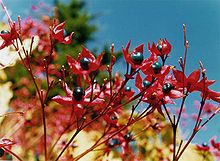| Clerodendrum | |
|---|---|

| |
| Clerodendrum trichotomum fruit | |
| Scientific classification | |
| Kingdom: | Plantae |
| Clade: | Tracheophytes |
| Clade: | Angiosperms |
| Clade: | Eudicots |
| Clade: | Asterids |
| Order: | Lamiales |
| Family: | Lamiaceae |
| Subfamily: | Ajugoideae |
| Genus: | Clerodendrum L.[1] |
| Type species | |
| Clerodendrum infortunatum | |
| Species | |
| Synonyms[1] | |
|
Adelosa Blume | |
Clerodendrum is a genus of flowering plants formerly placed in the family Verbenaceae, but now considered to belong to the Lamiaceae (mint) family. Its common names include glorybower, bagflower and bleeding-heart. It is currently classified in the subfamily Ajugoideae, being one of several genera transferred from Verbenaceae to Lamiaceae in the 1990s, based on phylogenetic analysis of morphological and molecular data.
Estimates of the number of species in Clerodendrum vary widely, from about 150[2] to about 450.[3] This is partly because about 30 species have been transferred to Rotheca,[4][5] about 30 more to Volkameria, and 1 to Ovieda.[2] The type species for the genus is Clerodendrum infortunatum.[6] It is native to Sri Lanka and the Andaman Islands.[7]
The genus is native to tropical and warm temperate regions of the world, with most of the species occurring in tropical Africa and southern Asia, but with a few in the tropical Americas and northern Australasia, and a few extending north into the temperate zone in eastern Asia.[8]
They are shrubs, lianas, and small trees, usually growing to 1–12 m (3 ft 3 in – 39 ft 4 in) tall, with opposite or whorled leaves. C. floribundum can grow to 30 m (98 ft) tall.[9] Clerodendrum fistulosum and Clerodendrum myrmecophila have hollow stems that are inhabited by ants.[8] Clerodendrum trichotomum is a common ornamental in warmer parts of the world.[8] Eight other species are also grown in the tropics for their abundant and attractive flowers.[10] One of these, Clerodendrum macrostegium, suckers abundantly from the roots, often producing a thicket within a few years.[10]
The following species are cultivated in the UK:
Clerodendrum species are used as food plants by the larvae of some Lepidoptera species including Endoclita malabaricus and Endoclita sericeus. Both butterflies and hummingbirds are often attracted to blooming clerodendrum.
- ^ a b "Genus: Clerodendrum L." Germplasm Resources Information Network. United States Department of Agriculture. 27 May 2010. Archived from the original on 29 June 2011. Retrieved 17 February 2011.
- ^ a b Yao-Wu Yuan, David J. Mabberley, Dorothy A. Steane, and Richard G. Olmstead. 2010. "Further disintegration and redefinition of Clerodendrum (Lamiaceae): Implications for the understanding of the evolution of an intriguing breeding strategy". Taxon 59(1):125-133.
- ^ Raymond M. Harley, Sandy Atkins, Andrey L. Budantsev, Philip D. Cantino, Barry J. Conn, Renée J. Grayer, Madeline M. Harley, Rogier P.J. de Kok, Tatyana V. Krestovskaja, Ramón Morales, Alan J. Paton, and P. Olof Ryding. 2004. "Labiatae" pages 167-275. In: Klaus Kubitzki (editor) and Joachim W. Kadereit (volume editor). The Families and Genera of Vascular Plants volume VII. Springer-Verlag: Berlin; Heidelberg, Germany. ISBN 978-3-540-40593-1
- ^ Dorothy A. Steane and David J. Mabberley. 1998. "Rotheca (Lamiaceae) Revived". Novon 8(2):204-206.
- ^ Rosette B. Fernandes and Bernard Verdcourt. 2000. "Rotheca (Labiatae) revived - more new combinations". Kew Bulletin 55(1):147-154.
- ^ Clerodendrum In: Index Nominum Genericorum. In: Regnum Vegetabile (see External links below).
- ^ a b Anthony J. Huxley, Mark Griffiths, and Margot Levy (editors). 1992. The New Royal Horticultural Society Dictionary of Gardening. The Macmillan Press Limited, London; The Stockton Press, New York.
- ^ a b c David J. Mabberley. 2008. Mabberley's Plant-Book third edition (2008). Cambridge University Press: UK. ISBN 978-0-521-82071-4
- ^ Floyd, Alexander G., Australian Rainforests in New South Wales Volume 2 - 1990 ISBN 0-949324-32-9 page 179
- ^ a b George W. Staples and Derral R. Herbst "A Tropical Garden Flora" Bishop Museum Press: Honolulu (2005)